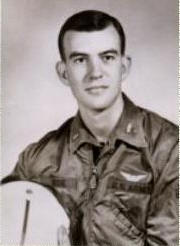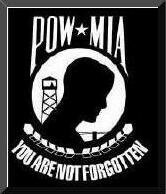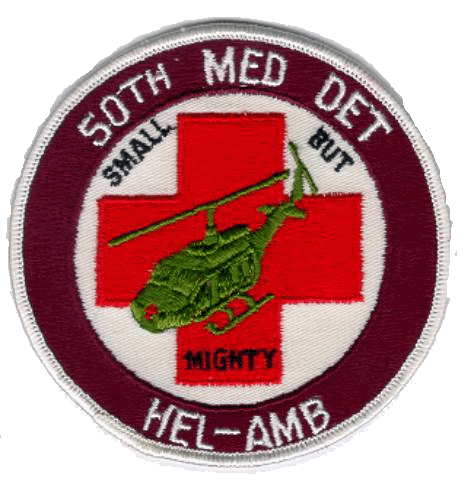![]()
1 Lt. Jerry Lee Roe
Dustoff 90


Name: Jerry Lee Roe Rank/Branch: O2/US Army Unit: 50th Medical Detachment, 43rd Medical Group, 44th Medical Brigade Date of Birth: 16 March 1943 (New Boston TX) Home City of Record: Houston TX Date of Loss: 12 February 1968 Country of Loss: South Vietnam Loss Coordinates: 121721N 1074713E (ZU030600) Status (in 1973): Missing In Action Category: 4 Aircraft/Vehicle/Ground: UH1H Refno: 1046
Source: Compiled from one or more of the following: raw data from U.S.Government agency sources, correspondence with POW/MIA families,published sources, interviews. Updated by the P.O.W. NETWORK in 2001.
Other Personnel In Incident: Wade L. Groth, Alan W. Gunn, Harry W. Brown (all missing)
REMARKS:
SYNOPSIS: On February 12, 1968, SP5 Harry Brown, medic; 1Lt. Jerry Roe,aircraft commander; WO Alan Gunn, pilot; and SP4 Wade Groth, crewchief, were flying A UH1H (tail #66-17027) dispatched on a night medical evacuation missioN (dustoff). Dustoff 90 departed Ban Me Thuot, South Vietnam for Gia NghaI Special Forces camp.
As U.S. Air Force Tactical Control Radar operators at Ban Me Thuot tracked the flight, the blip that was the UH1H dustoff chopper disappeared from the screen at 2019 hours. The helicopter apparently went down 20 minutes outbound from its base in a mountainous region of Quang Duc Province.
An Army Infantry unit searched the apparent crash site near the Cambodian border for 36 hours, but found neither the helicopter nor its crew. Snipers were not known to be in the area, and it is not believed the helicopter was shot down, according to an Army report, indicating possible mechanical trouble. In April 1969, CIA was asked to analyze the positive identifications made by a rallier of a number of photographs of missing Americans. The rallier selected the photos of both Harry Brown and Jerry Roe as two men he believed to have been prisoners of war. CIA could not determine why the source selected them.
In 1979, Sean O'Toolis, an Irish-American, was touring Bong Song Camp, 40 miles south of Hanoi, on an IRA gun-buying mission, when he alleges he met and spoke with American prisoners, Brendon Foley and Wade Groth, a prison workmate of Foley's. He also claims to have talked to men named MacDonald, Jenning and an O'Hare or O'Hara. He brought a message to Foley's brother and fingerprints of Foley and O'Hara. He identified old photos of Groth, and gave believable descriptions of Foley and Groth. Neither family knows whether or not to believe O'Toolis, as much of his account of his travels seems incorrect.
Whether the four men aboard the dustoff lost on February 12, 1968 survived to be captured is unknown. The coincidence of two separate sources identifying three members of the crew seems to strong to ignore. The U.S.Government does not believe there is any substance to these reports. Based on thousands of still-classified sighting reports, many experts believe hundreds of Americans did survive, and are still alive, waiting to be brought home. If even one is alive, he must be brought home.
![]()

February 1968 medevac crew still has not returned
On the evening of Feb. 12, 1968, aircraft commander Lt. Jerry Lee Roe, call sign "Dustoff 90," and his crew: CW2 Alan Gunn, pilot; Spec. 5 Wade L. Groth, crew chief; and their, medic, Spec. 5 Harry W. Brown, departed Ban Me Thuot in their UH-1H for an urgent medivac at the Gia Nghai Special Forces Camp.
The crewmembers and helicopter were from the 50th Medical Detachment (Helicopter Ambulance), normally stationed at Tuy Hoa, and were on standby at Ban Me Thuot in support of Special Forces operations in the area.
At about 8:19 p.m., 20 minutes out of Ban Me Thuot, Dustoff 90's blip disappeared from the U.S.A.F. TAC control radar screen.
There was no "May Day" call or indication there were any problems. That last position would have put them close to the top of a mountain we commonly called "VC Mountain".
The mountain had plenty of Triple A and small arms fire from the enemy, so it was normally avoided like the plague.
Yet the coordinates given for the last contact was about 100
meters from the top of the mountain.
Helicopter crews from the 155th Assault Helicopter Company were
dispatched for search and rescue operations.
An Air Force AIE Sandy joined the search and reported seeing
"fire and lights" on the mountain.
The following morning, a helicopter crew from the 50th Medical Detachment piloted by the unit's commanding officer, Maj. Ronald C. Jones and the unit's XU, Uapt. Ronnie Porta, arrived and joined the search and rescue effort.
A Special Forces soldier using a "sniffer" device which detects the presence of ammonia in human urine also joined the crew. Flying low and slow over a mountain you normally could not fly close to made the search seem almost surrealistic.
We could have reached out and picked the leaves off the trees. It was unbelievable.
SOP for search and rescue operations: After three days of searching, if the crew or helicopter had not been sighted, the operation was suspended and the crew listed as missing in action.
Per SOP, the search and rescue on was officially suspended many pilots from the 50th MedDetachment would continue to search during missions in the area.
Now things begin to get strange.
It's 1970, and Ronnie Porta is back in Vietnam as a major and in command of his own dustoff unit.
He receives a call at Cu Chi from a friend at Ban Me Thuot who was there when Dustoff 90 went down.
His friend tells him the aircraft was found intact, minus rotor blades, of course. His friend believed the crash was survivable. They found an ambu bag, a pair of goldrimmed glasses, spent M-79, M-16, and .30-caliber carbine ammo casings, and part of a flak jacket.
Memorial Day, 1986: I had a report pulled from the POW/MIA database maintained by the National League of POW/MIA Families. Lt. Roe and Spec. 5 Brown were identified as POWs.
In April of 1969, the CIA was asked to analyze a positive identification by a "Rallier" who had selected their pictures from a book of personnel listed as missing in action.
The CIA had determined it was only a "coincidence" a "Rallier" could positively ID two people from the same helicopter crew; one black, one white, one located in the front of the book under Brown, and the other listed near the back of the book under Roe? (Just a coincidence?)
According to the "Rallier" the location of the POW compound where they were being held at the time was about two miles from Camp Eagle, "home" to the 101st Airborne.
I decided to look up Wade Groth, also. In 1979, about six years after all POW/MIAs not returned in "Operation Homecoming" had been declared dead by Hanoi and Washington, Groth had been seen alive and in good condition in a place called Bong Song about 40 miles south of Hanoi, working on a railroad section.
An IRA gunrunner by the name of Sean O'Toolis spoke to Groth, Brendon Foley, and another POW named MacDonald. O'Toolis was able to obtain a fingerprint of Foley and a note for his brother.
He gave the CIA sketch artist a description so accurate it was easy to tell it was Groth - red hair, freckles and all.
O'Toolis' word supposedly couldn't be "trusted". He was a gunrunner and worked for the IRA, and, therefore, was disreputable in our govemment's eyes. Since he freely took this evidence to the CIA, I would think he had some connections there.
October 26, 1992: A search team finds what it believes is the bum spot left by a crashed and burned UH-1H. Members of the team also find the same things I mentioned before: Ambu Bag, gold-rimmed glasses, part of a flak jacket, spent M-79 casings, and all the rest, but they are here to bury this crew, not to find them .
So, due to the size and depth of the bum spot, the team reported the aircraft crashed into the mountain with such force it exploded and the entire crew was killed.
Excuse me, but the search team grossly oversimplified its "findings" on this point, 22 years after the aircraft had been found comparatively intact in 1970. No human remains were found!
What really happened to Jerry Roe and the crew of Dustoff 90? Are they prisoners of war or are they dead?
I am looking for anyone from the 155th Assault Helicopter Company who may have witnessed the finding of Dustoff 90's helicopter in 1970, or the person who called Maj. Porta with the information.
The standard procedure when I was in Vietnam (1967-68) was, if the aircraft couldn't be recovered, it was to be destroyed in place. In other words, the helicopter would have been blown up or burned by our side.
So, if an otherwise intact "bird" had been blown in place by our forces, the search team, not knowing this, would naturally come to the wrong conclusions, based only on what they saw at the crash site.
You would think also that nearly everyone "in the business" would know the difference between spent rounds that have been fired and those that have simply exploded in a fire.
The implication, of course, is plain: If the cartridge casings were from fired rounds, then Dustoff 90's crew was alive enough to engage in a firefight after they were on the ground.
They were never confirmed KIA (killed in action). Three of them were reported as having been seen alive. Therefore, they are still missing in action! We have one mission still out: Dustoff 90.
Courtesy Vietnam Helicopter Pilots Association Newsletter 2001
![]()
Just Click on the Dog Tags
to be taken to my Welcome Page
Follow the Dog Tags to my Menu Page....
the Dog Tags lead the way